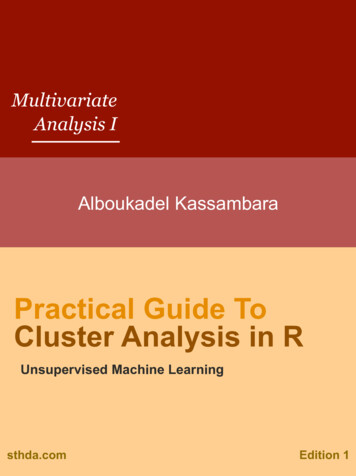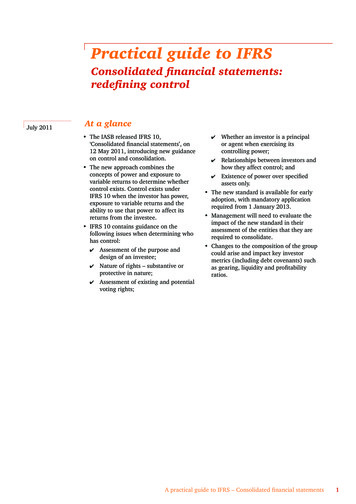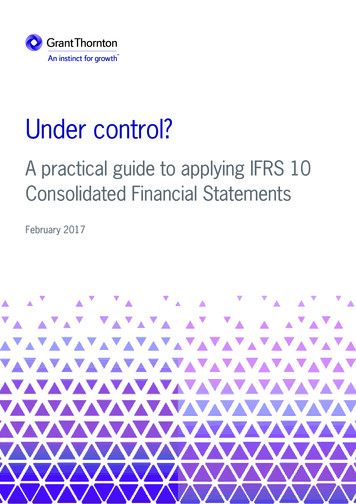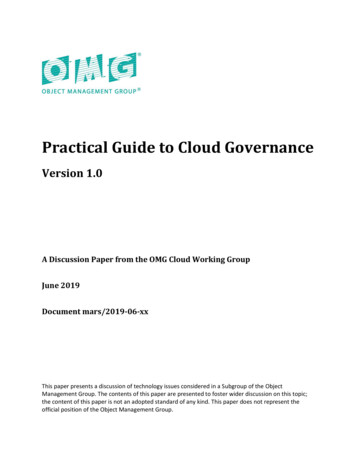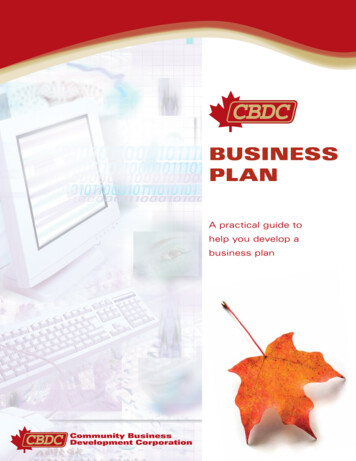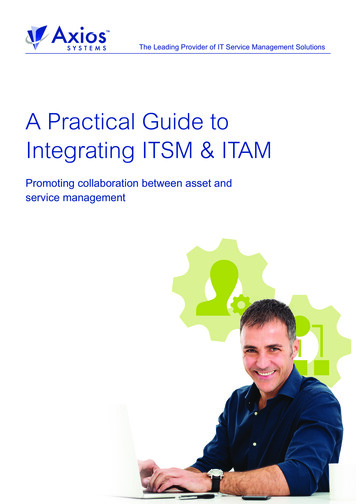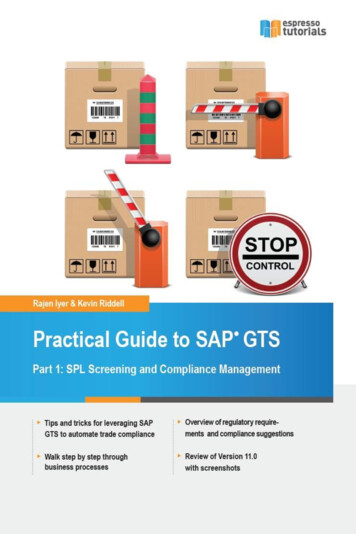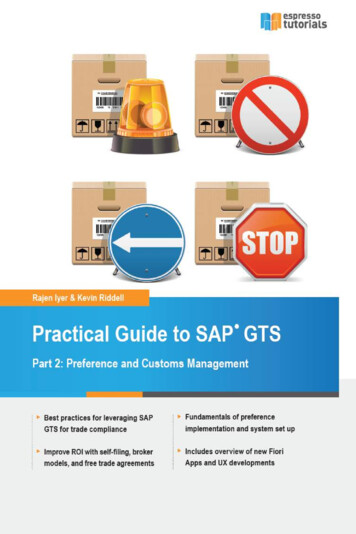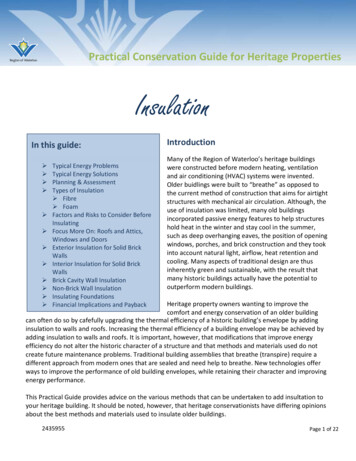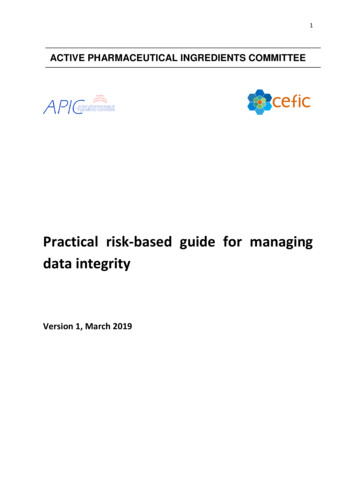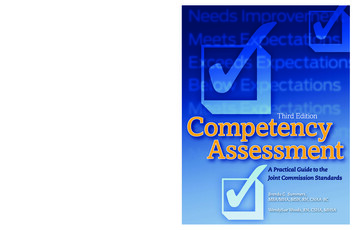
Transcription
Competency AssessmentA Practical Guide to the Joint Commission StandardsBrenda G. Summers, MBA/MHA, MSN, RN, CNAA-BCWendySue Woods, RN, CSHA, MHSAThird EditionStay in compliance with this easy-to-use resource! Competency Assessment:A Practical Guide to the Joint Commission Standards, Third Edition, is an updatedguide to The Joint Commission’s competency assessment standards and includescustomizable tools and techniques to help hospitals establish and implementeffective competency programs.Your one-stop competency compliance guideSummers WoodsThis book and CD-ROM set is your perfect solution to competency assessmentcompliance. This handy resource will help you to: Understand the intent of each Joint Commission standard and how bestto comply, as well as demonstrate compliance to surveyors Learn how to assess competency, including population-served (age-specific)competencies Create effective strategies for carrying out ongoing competency assessments Customize the tools and techniques provided for your competencyassessment program Benefit from knowing what do to with the results of your assessmentsCompetency Assessment: A Practical Guide to the Joint Commission Standards,Third Edition, includes a CD-ROM full of job descriptions and competency plansyou can customize to meet your facility’s needs. This easy-to-reference guideprovides real-world strategies, as well as useful forms and practical tools that youcan incorporate into your own competency assessment program immediately. 2008 HCPro, Inc. HCPro is not affiliated in any way with The Joint Commission, which owns the JCAHO and Joint Commission trademarks.CA3200 Hoods Lane Marblehead, MA 01945www.hcmarketplace.comA Practical Guide to theJoint Commission StandardsBrenda G. Summers,MBA/MHA, MSN, RN, CNAA-BCWendySue Woods, RN, CSHA, MHSA
CompetencyAssessmentA Practical Guide tothe Joint CommissionStandardsThird EditionBrenda G. SummersMBA/MHA, MSN, RN, CNAA-BCWendySue WoodsRN, CSHA, MHSA
Competency Assessment: A Practical Guide to the Joint Commission Standards, Third Edition, is published byHCPro, Inc.Copyright 2008, 2004, 2001 HCPro, Inc.All rights reserved. Printed in the United States of America.5 4 3 2 1First edition published 2001. Second edition 2004. Third edition 2008.ISBN # 978-1-60146-251-0No part of this publication may be reproduced, in any form or by any means, without prior written consent of HCPro,Inc., or the Copyright Clearance Center (978/750-8400). Please notify us immediately if you have received an unauthorized copy.HCPro, Inc., provides information resources for the healthcare industry.HCPro, Inc., is not affiliated in any way with The Joint Commission, which owns the JCAHO and Joint Commissiontrademarks.Brenda G. Summers, MBA/MHA, MSN, RN, CNAA-BC, AuthorPaul Singer, Layout ArtistWendySue Woods, RN, CSHA, MHSA, AuthorMatthew Kuhrt, CopyeditorJay Kumar, EditorSada Preisch, ProofreaderBrian Driscoll, Executive EditorDarren Kelly, Books Production SupervisorJohn Novack, Group PublisherSusan Darbyshire, Art DirectorJackie Diehl Singer, Graphic ArtistJean St. Pierre, Director of OperationsAdvice given is general. Readers should consult professional counsel for specific legal, ethical, or clinical questions.Arrangements can be made for quantity discounts. For more information, contact:HCPro, Inc.P.O. Box 1168Marblehead, MA 01945Telephone: 800/650-6787 or 781/639-1872Fax: 781/639-2982E-mail: customerservice@hcpro.comVisit HCPro at its World Wide Web sites:www.hcpro.com and www.hcmarketplace.com09/200821498
ContentsAbout the authors.vPreface.viiChapter 1: Competency basics.1Definitions and examples of low-volume/high-risk, new or changed,problem-prone, and mandated duties.8Chapter 2: Competency assessments and the JointCommission standards.17Competency assessment tool.35Chapter 3: Six steps to a successful competency program.37Example of portion of department-specific guidelines.50Sampling of population-specific components.51Review process categories.57Hospitalwide medication errors.59Fourth floor medication errors.59Fourth floor medication errors by type and shift.60Sample questions for self-assessment of motivation.63Chapter 4: What is the competency validation cycle?.67Chapter 5: What are validation methodologies?.81Validation methodologies and the dimensions of competency they measure.86Chapter 6: Ongoing measure of core competency.97Analyzing medication error data.103Aggregated medication error data.104C ompetency A ssessment , T hird E ditioniii
C o n te n t sChapter 7: The competency validation process.107Competency validation process.110Applicant worksheet.111Registered nurse job description.114Registered radiologic technologist job description.120Security officer job description.126Ongoing competency assessment, Sample 1.130Ongoing competency assessment, Sample 2.131Ongoing competency assessment, Sample 3.132Annual performance evaluation: Organizational competencies.133Chapter 8: Managing the competency program.139Ongoing competency statement.144Competency Management Council.146ivC ompetency A ssessment , T hird E dition
About the authorsWendySue WoodsWendySue Woods, RN, CSHA, MHSA, brings exceptional accreditation compliance and processimprovement expertise to her clients. She has more than 20 years of consulting experience andfrontline, real-time success in Joint Commission accreditation, regulatory/risk management compliance, medical staff leadership, process improvement strategies, customer service, and administrative facility operations.Prior to becoming a full-time consultant for The Greeley Company, Woods served in varying hospital administration roles related to quality management and medical staff leadership. She hassuccessfully led organizations to Joint Commission accreditation compliance, achieving accreditation without recommendations for improvement. Woods served as Administrator of Operationsand Ancillary Services for a hospital-owned, Joint Commission-accredited physician group. Hercustomer satisfaction programs have resulted in increased annual scores and greater marketshare. Her varied experience and ability to understand compliance, implement pro cess improvement strategies across all levels, and provide staff education across the continuum, bring a comprehensive and realistic approach to reengineering and regulatory compliance.Woods’ ease with her clients and audience allows organizations to better understand the valueof process improvement, customer service, and regulatory compliance and gain the ability toincorporate it into daily operations. She brings enthusiasm and a practical approach to healthcareaccreditation. She has addressed healthcare audiences throughout the Southeast on topics varyingfrom medical staff leadership, organizational improvement, team building, and Joint Commissionaccreditation. Woods is a registered nurse and also holds a master’s degree in health scienceadministration.C ompetency A ssessment , T hird E ditionv
Aboutthe authorsBrenda G. SummersBrenda G. Summers, MBA/MHA, MSN, RN, CNAA-BC, is a senior consultant with The GreeleyCompany of Marblehead, MA, focusing on the areas of accreditation and regulatory compliance.She brings more than 16 years of experience in healthcare leadership to her work with healthcarecenters across the country. Summers applies her years of healthcare leadership and clinical andregulatory expertise to help clients understand and meet accreditation standards and complianceexpectations. Her in-depth understanding of organizational dynamics and the nature of change,even in times of turbulence, allows her to bring a realistic approach to organizational problemsolving and strategic and operational process design.She presents at state and national seminars, participates in topical audio conferences, and hasauthored several trade publications. Summers has particular expertise in the area of effectivecompetence validation and performance review processes redesign, and consults in all areas ofaccreditation and regulatory compliance, process improvement, sustained change, and effectivemodels for education.Prior to joining The Greeley Company, Summers held senior leadership positions in hospitals inboth North and South Carolina. Immediately prior to joining The Greeley Company, she servedas vice president for administration and chief nursing officer for The Mercy Hospitals in Charlotte,North Carolina. She had direct reporting responsibility for all patient care areas, as well as manyother clinical and non-clinical departments of the organization. She successfully introduced anumber of change initiatives that resulted in improved patient, staff, and physician satisfaction,improved patient outcomes, and financial success of the organization. While in her senior leadership position, she also had responsibility for accreditation and regulatory affairs for the organization, and was able to coordinate sustained compliance activities in these arenas.Summers holds an MBA/MHA from Pfeiffer University. She received a B.S. and M.S. in nursing from the University of North Carolina, Chapel Hill. She is certified by the ANCC in NursingAdministration, Advanced and is a member of Sigma Theta Tau, the International Honor Societyof Nursing.viC ompetency A ssessment , T hird E dition
PrefaceComplying with The Joint Commission (TJC) standards and maintaining accreditation can bechallenging, time consuming, and frustrating. It’s not uncommon to hear staff in healthcarefacilities complain that the time they spend dealing with compliance issues and survey preparation takes away from their top priority: caring for patients. In some instances, staff members arejust expressing their frustrations, but in others, they have lost sight of one important fact: JointCommission standards are intended to promote safe, effective patient care.Once organizations begin to view TJC standards as a vehicle for maintaining and improving quality of care and patient safety, they’re likely to spend less time reading the fine printin their accreditation manual and more time talking about what’s best for patients. Organ izations should not assess competency simply because a regulatory body mandates it be done.Competency assessment should bring value to the patient, the employee, and the organization.It is a critical component of any process design or redesign, whether in response to opportunities identified through the facility’s internal monitoring and evaluation activities or directed byan external source.Competency assessment does not have to be a laborious, repetitious, paper-only process. Organ izations should design a process that is both efficient and meaningful, and when appropriate, fun and memorable. To streamline the process and give it meaning, organizations shouldembrace the synergy between human resources (HR) and the environment of care (EC), infection control (IC), and performance improvement (PI) functions, and use aggregate data from allthese sources.Today, healthcare leaders are challenged to lay a firm foundation for competency assessmentand implement an ongoing and interactive verification of knowledge and skills, while promoting a culture of safety. The goal is to provide high-quality patient care through skilled, competent personnel whose competency is validated and maintained via a structured program. Thisbook provides organizations with the essential definitions and tools they need to understandC ompetency A ssessment , T hird E ditionvii
P re facecompetency assessment requirements and develop and implement effective competency assessment programs in their facilities. It has been updated to address competency as it relates totracer methodology, the evaluation of orientation, and the process for competence validation.We provide a model for competency validation and discuss the six steps to a successful program.A detailed discussion of the role data can play in the assessment of ongoing competence is alsoincluded.viiiC ompetency A ssessment , T hird E dition
ChapteroneCompetencybasics
Competency basicsEstablishing and implementing a thorough and effective, competency assessment program is the key to complying with the Joint Commission’s (TJC’s) competency-relatedstandards. A competency assessment program should focus on identifying, verifying, andvalidating the skills and abilities of staff members to ensure that they meet the organization’s standards. If the quality of staff skills and abilities remains high, then it is likely thatthe quality of patient care and services will also remain high. This chapter defines keycompetency-related terms and explains the various ways in which healthcare organizations apply the term “competency assessment.”What is competency?Competency is the demonstrated ability to fulfill the primary responsibilities of the position for which a person was hired. Observing and measuring competency for every position in the facility, including health-occupation students (i.e., students of nursing, pharmacy, imaging, and rehabilitation, etc.) and volunteers who work in the same capacityas staff in providing care, treatment, or service, gives leaders confidence that healthcareproviders are exercising care, caution, and concern for the patients.Healthcare facilities should develop competency programs for several reasons, one ofwhich is that TJC requires such programs. However, competency programs are importantfor reasons other than TJC compliance. Well-designed competency programs have threeimportant functions: To help facility leaders stay focused on their primary objective: the facility’smission statement To assist in matching applicants to open positionsChapterChapteroneWhy develop a competency program?
Chapterone To ensure ongoing assessment of staff competency from system entry through the remainder of the person’s association with the organizationThe following TJC HR standards provide the framework for a comprehensive competency program. They also guide HR department personnel and department leaders in developing a programthat fulfills the above three functions and supports their expectations of performance in the facilityand their departments: HR.1 requires leaders to identify the qualifications for each position in the facility, addresses at-hire competency validation, and requires leaders to ensure staffing effectiveness. HR.2 requires facilities to orient new staff, students, and volunteers to the organization,the department/unit/area in which they will work, and their job; establishes a process tovalidate staff, student, and volunteer competency by the end of orientation; and providescontinuing education and training. HR.3 requires leaders to establish a process for validating ongoing competency of staff,students, and volunteers who work in the same capacity as staff providing care, treatment,or service; and to periodically conduct staff performance reviews.Developing a specific goal with clearly defined objectives will assist leaders in implementing ameaningful competency assessment program. Below is a sample goal for a competency assessment program:The goal of the competency assessment program is to fulfill the mission, vision, and value statements of the hospital by ensuring that qualified and competent staff provide high-quality services.Objectives of the competency program are to: Establish a policy that defines the competency program on the facilitywide and department-specific levels Develop and implement the following department-specific components:- Competency-based job descriptions for every position in every department- Orientation programs for every department/unit that includes the department’s functions and responsibilities4C ompetency A ssessment , T hird E dition
Competencybasics Develop each leader’s interview and critical judgment skills in order to enable him or herto identify those candidates who will successfully fill open positions Establish a background check that includes:- A completed application- Primary source verification and validation of licensure, certification, or registration,when required by law in order to practice- Verification and validation of licensure, certification, or registration, when required bythe organization- Reference checks of personal and professional contacts- Criminal and other background checks as required by the organization Establish a mechanism to ensure that every employee attends all aspects of orientationrequired by the organization for completion by clinical staff before the individual beginsproviding care, treatment, or service to patients; attends the aspects of orientation to thejob for which the organization has determined the employee can be oriented as he or sheprovides care, treatment, or service; and orientation to the facility within the time definedby organization leaders Establish a plan to ensure that competency is validated within the designated orientationperiod Ensure that performance evaluations are completed and given to the employee in the timeframe established in the facility’s policy Participate in an ongoing educational program and a competency validation process thatare based in part on the results of performance evaluations and other data sources Design department-specific educational programs that target improvement in staffcompetency Establish a database to ensure that licenses, certifications, and registrations are currentC ompetency A ssessment , T hird E dition5
ChapteroneWho needs to be assessed?All staff members—including those providing care, treatment, or service under contractualarrangements—studen
assessment program Benefit from knowing what do to with the results of your assessments Competency Assessment: A Practical Guide to the Joint Commission Standards, Third Edition, includes a CD-ROM full of job descriptions and competency plans you can customize to

